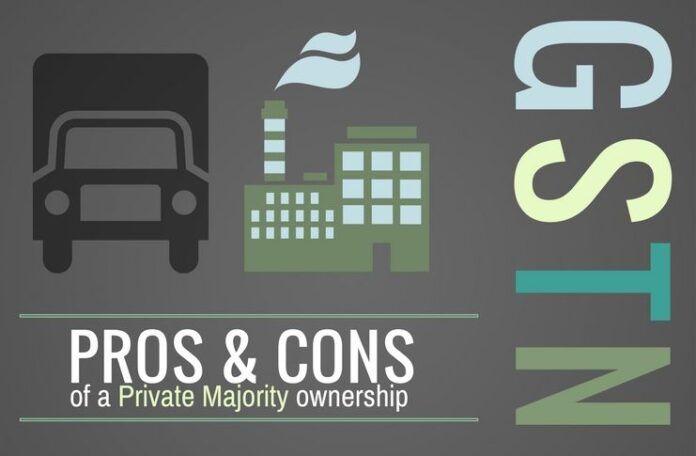
[dropcap color=”#008040″ boxed=”yes” boxed_radius=”8px” class=”” id=””]G[/dropcap]oods and Services Tax [GST] is a broad-based, comprehensive, single indirect tax which will be levied concurrently on goods and services across India. It will replace most of the Central and State indirect taxes such as Value added Tax (VAT), Excise Duty. Service Tax, Central Sales Tax, Additional Customs Duty and Special Additional Duty of Customs. GST will be levied at every stage of the production and distribution chains by giving the benefit of Input Tax Credit (ITC) of the tax remitted at previous stages; thereby, treating the entire country as one market. Introduction of Goods and Services Tax (GST) in India is perceived to be the most ambitious initiative in the arena of indirect tax reform. It would change the Indian tax structure and pave the way for modernization of tax administration.
Already GST bill has been approved by both the houses of Parliament and getting approved by State assemblies. It needs fifty percent or 15 assemblies to approve for getting Presidential assent.
It is unfortunate that no discussion is taking place about this GSTN and it would be most appropriate if the Finance Ministry comes out with clarifications and also make GSTN a government company which can be audited by the CAG.
[dropcap color=”#008040″ boxed=”yes” boxed_radius=”8px” class=”” id=””]A[/dropcap] company has been set up primarily to provide IT infrastructure and services to the Central and State Governments, tax payers and other stakeholders for implementation of the Goods and Services Tax (GST). Goods and Services Tax Network (GSTN) is a Section 25 (not for profit), non-Government, private limited company. It was incorporated on March 28, 2013. The Government of India holds 24.5% equity in GSTN and all States of the Indian Union, including NCT of Delhi and Pondicherry, and the Empowered Committee of State Finance Ministers (EC), together hold another 24.5%. Balance 51% equity is with non-Government financial institutions. The Authorised Capital of the company is Rs.10 crores ($1.5 million).
As politicians argue fiercely and persistently over the nitty-gritty of this long-awaited and ambitious indirect tax reform that promises to make India a common market, the organisation responsible for creating and managing the complex IT backbone that will make GST operational, the Goods and Services Tax Network(GSTN), has moved, without fanfare, into glitzy new headquarters at Worldmark I, part of a vast commercial multi-storey chain owned by Sunil Mittal-promoted Bharti Realty.
The 30,000 square foot space that GSTN occupies on the fourth floor couldn’t be a bigger contrast to its cramped quarters in Hotel Janpath in central Delhi, a temporary base of operations after it was incorporated in March 2013. There is little to suggest that this Section 25 (not-for-profit) company is a government organisation in which the Centre and states hold 24.5 per cent each (a clutch of banks and private sector institutions hold the rest).
With its carefully delineated spaces, clean lines and such stylish trimmings as jazzily coloured “breakout rooms”, a canteen where it is compulsory for all staffers, chairman downward, to eat, and a “ladies’ room” for expectant mothers to rest, this could readily be mistaken for the office of a Private Equity (PE)/ Venture Capital (VC) funded IT start-up run by a 30-something entrepreneur. The ambience is not accidental either. As GSTN Chairman Navin Kumar had told Business Standard a year ago, “The idea is to create an entity that is under the strategic control of the government but will have the flexibility of the private sector.”
As if to highlight the difference, a racy blue, red and green logo, created by the National Institute of Design, adorns a banner at the airy reception area and the visiting cards and stationery. These are only the outward signs of the solid, if low-profile, progress the organisation has made to get the IT infrastructure ready for when this long-delayed tax becomes a reality. A world away from the din of political rhetoric over rates, the shape of the law, minimum applicable thresholds and, most recently, the prospect of a 1 per cent inter-state tax, GSTN has made some robust progress.
Government has given GSTN Rs.320 crores ($47.88 million) for funding companies to purchase hardware needed for the system and are going to give some more money.”
Asked about the government’s initiative to connect products and SME customers with start-ups to GST platform, Prakash Kumar [CEO] said a few start-up companies have already begun to approach the government and suggest innovative ideas of developing applications to help them connect their products and SME customers to GST platform.
“A couple of start-ups came to me, and one of them I met was zapped by their innovation. Yes we need very innovative start-ups to add value to the GST platform. We need at least 10 to 12 such applications developed by start-ups,” he added.
[dropcap color=”#008040″ boxed=”yes” boxed_radius=”8px” class=”” id=””]I[/dropcap]t was the speech of Budget, 2010-11 when the then Finance Minister – Shri Pranab Mukherjee announced the setting up of a “Technical Advisory Group for Unique Projects” (TAGUP). TAGUP was set up under the chairmanship of Shri Nandan Nilekani for taking up the technological and system related issues in respect of five projects including GST. It was the report of TAGUP submitted in January, 2011 which suggested that the task of handling the IT related issues in respect of these five projects should be handed over to a class of institutions called “National Information Utilities” (NIU). It was also suggested that the NIU will be the reporting authority to government and it will further contract to vendors in market for specialized IT related services.
Later on, in July 2010, Shri Pranab Mukherjee, with the assent of the EC set up an Empowered Group on IT Infrastructure for GST (EG-IT) which was also headed by Shri Nandan Nilekani. It was a dedicated group which was entrusted the job to look into technological needs for implementing GST. It is worth mentioning here that TAGUP was responsible for making recommendations in respect of five projects already identified at the time of announcing budget, 2010-11 while EG-IT was responsible to work upon GST network only.
Based on the reports of these two groups, it was decided that:
-
NIU for GSTN should be incorporated as a non-government, not for profit (section 25), Private Limited Company registered under the Companies Act, 1956.
-
Government’s share in equity should be 49%; being 24.5% of Centre and 24.5% of State.
-
Total private ownership should be 51%.
-
No single private entity should hold more than 10% of equity.
Thus, basically, the GSTN is to be in the hands of the private sector with 51% of shares.
Objectives of GSTN
GSTN has been set-up with the following objectives to act as a pass through interface for dealers.
-
Integration of the common GST Portal with the existing tax administration systems of the Central/State governments and other stakeholders.
-
Provide common PAN based registration, enable returns filing and payment processing for all states on a shared platform.
-
Facilitation, implementation and set standards for providing services to the taxpayer through common GST portal State Governments and other stakeholders;
-
Build efficient and convenient interfaces between with tax payers to increase tax compliance;
-
Carry out research, study best practices and provide training to the stakeholders
- नकली खबर लक्षण है, बीमारी नहीं! - April 16, 2018
- Fake News/ Accreditation and Sedition - April 4, 2018
- Two Poisonous Seeds - March 15, 2018
[dropcap color=”#008040″ boxed=”yes” boxed_radius=”8px” class=”” id=””]T[/dropcap]he select committee of Parliament [RajyaSabha] has suggested “The GSTN is the comprehensive back end infrastructure network for the management of tax data and reporting of the GST. The Committee noted that the Non-Government shareholding in GSTN is dominated by private banks, and this is not desirable. It recommended that the Non-Government Institutional shareholding be limited to public sector banks and financial institutions.”
The objections raised by the Committee are quite obvious and they simply cannot be ignored in the light of the fact that GSTN would be a database of almost every significant transaction being carried out in the economy. GSTN’s work is of strategic importance to the country and the firm would be a repository of a lot of sensitive data on business entities across the country.
Main Concerns
Everything relating to GSTN was not so agitating until it was revealed that 51% of the shareholding of GSTN would lie in the hands of private sector. The privatization of GSTN is more threatening as GSTN would be a storehouse of a large amount of critical information. Thus, a majority private shareholding of such company means the critical information of about 6 million taxpayers is in the hands of private players. GSTN has been incorporated as a not-for- profit Section 25 Company. It is a well-known fact that private sector works only for profit. It is quite unusual for a private sector entity to invest for public welfare. This very fact induces a serious question as to why is private sector investing in a not-for-profit Company? Certainly, some kinds of incentives or interests must be associated with the investment. And when it is clearly evident that no monetary benefit is going to emerge out of it, it would not be wrong to assume the presence of some bigger non-monetary incentives. Or rather, it can be said that the availability of such critical data relating to the taxpayers itself is the biggest advantage associated with it. This threat alone is the major cause of concern for people arguing against the privatization of GSTN. Going by the above arguments, it can be safely opined that such critical information relating to taxpayers must not be given in the hands of such private entities.
[dropcap color=”#008040″ boxed=”yes” boxed_radius=”8px” class=”” id=””]T[/dropcap]he taxation system of any country is always considered to be the safest when it is under control of the state. Handing over the control of such sensitive data in the hands of the private sector is itself the biggest threat to the economy. How shall the government ensure the economic security of nation if such data is misused by the private entities to get benefit out of it?
At this stage, it must be noted that concerns had been raised even by the Central Board of Excise and Customs (CBEC) regarding ownership and security of such sensitive and confidential data in the dominion of private sector owned GSTN but it was later decided not to question the decision of the empowered committee. This concern was not considered before proceeding with the registration of GSTN, ignoring the fact that CBEC is the most important stakeholder in this transitive tax revolution. What induces more questions is that GSTN, being a private company, shall be out of the ambit of the office of The Comptroller and Auditor General (CAG). Considering the above arguments, it would not be wrong to question the security and confidentiality of the critical taxpayers’ database.
…mechanisms to avoid conflicts of interest as well as sacrificing interests of the State for the benefit of a few.
What could be the possible reasons behind private equity in GSTN? Is it indicating the government’s inability to efficiently manage the biggest tax revolution of the nation? Is the government trying to shed off its responsibilities? Why does the government want to keep GSTN out of the ambit of CAG?
The current proposed structure of GSTN is based upon the recommendations of TAGUP and EG-IT which had given their reports after a number of rounds of discussions.
The Empowered Committee (EC) has suggested that concerns regarding the data security should be addressed by incorporating related provisions in the Articles of Association of the company entrusted with GSTN. EC has also clarified that the Chairman of GSTN would be appointed by the Government. Also, as stated earlier, no single private entity will own more than 10% of equity while Centre and State will own 24.5% equity each. Thus, ultimate control will vest with government anyways. Further, a monitoring committee headed by Revenue Secretary was also proposed to be constituted to review the working of GSTN.
[dropcap color=”#008040″ boxed=”yes” boxed_radius=”8px” class=”” id=””]T[/dropcap]he EC also stated that the GSTN will be bound to follow the internationally accepted security and safety measures of protecting the data leakage. Also, it was proposed to appoint a Chief Information Security officer on deputation by Government to look into the matters related to information security. EC also clarified that the audits of GSTN would be conducted by independent auditors, including the professional personnel designated for carrying out technology reviews and giving suggestions thereupon.
The above stated justifications were given by EC in respect of information protection mechanism while finalizing the model of GSTN. However, these are the least discussed in the relevant fora.
From that point of view the concerns of Dr Swamy seem justified.
BJP leader Subramanian Swamy on Thursday urged Prime Minister Narendra Modi to bring full Government control in the company called GSTN, formed by UPA Government with 51 percentage private participation to manage the administration of Goods and Services Tax (GST). In a letter to Modi, the BJP leader said it was not advisable to bring private firms in the administration of tax-related matters.
Goods and Services Tax Network (GSTN) was formed as a Section 25 company in March 2013 with Centre and States having 49 per cent. Rest 51 per cent of shares were controlled by private banks and National Stock Exchanges’ subsidiary company. Ten percent of shares each were held by HDFC Bank, ICICI Bank, HDFC Ltd and NSE Strategic Investment Corporation. Eleven percent shares are held by LIC Housing Finance Limited, where Bank of Muscat and Abu Dhabi Investment Corporation also have shares, said Swamy.
“Being a Section 25 company, GSTN is a not-for-profit organisation. Then why private profit making entities have any stake, and that too majority stake in it? What is in it for them? Implementing GST scheme requires Constitutional Amendments and then only the GST administration and tax Management Company would be by GSTN. All the data management for computation of tax share, will be by GSTN,” said Swamy arguing that the programming work and electronic management should be handled by Government itself.
“Tax administration is a matter that deals with sensitive private information. Being such a large shareholder, this automatically means that HDFC and ICICI will be the bankers of public money collected through taxes,” he said, citing a recent transfer of Rs.4,000 crores ($600 million) by GSTN to develop software.
– The Pioneer
Conclusion
[dropcap color=”#008040″ boxed=”yes” boxed_radius=”8px” class=”” id=””]I[/dropcap]t might be worthwhile to put together a policy/ guideline paper on appropriate vs inappropriate engagement with government projects or initiatives including the rules for conflict of interest. Right now, very few seem to know where the actual lines are. So it ends up being a free for all.
If I recall correctly there were allegations that Sam Pitroda during his tenure at CDOT/ Telecom etc. staffed hordes of companies with relatives and then collected government contracts. Similar is the case with a large number of World Bank assigned projects with the Finance Ministry—which are contracted to small companies floated by parties having insider knowledge. But the average person has no idea where the lines were crossed and where they weren’t. Short of a getting a law degree oneself, I can’t even see how the average person is supposed to know where the lines are.
I think it would be a huge social service to tell the nation a-priori what the lines are as opposed to retrospectively establishing them by precedent or worse a letter of indulgence from a higher power.
It is unfortunate that no discussion is taking place about this GSTN and it would be most appropriate if the Finance Ministry comes out with clarifications and also make GSTN a government company which can be audited by the CAG.
This sums up mechanisms to avoid conflicts of interest as well as sacrificing interests of the State for the benefit of a few.
Note:
1. The conversion rate used in this article is 1 USD = 66.83 Rupees.
2. Text in Blue points to additional data on the topic.











It is not clear how 100% holding by governent will help. if anything, it will make things much worse, what with bureaucracy, cronysm, corruption, not to mention delays & known inefficiencies of the government systems. I can’t see what is the problem if ICICI & HDFC took the initiative and invested into GSTN as they evidently see a lot of business potential. Let us say 10% limit itself is too high, other interested players including public sector banks could be offered equity and individual holding may be restricted to 5% or so. With 49% investment, the govt. remains the biggest investor and limit on individual holding ensures no dominance by any single or even a few investors. it certainly needs to be out in the public and widely debated but not pushed into a govt. department on baseless fears. A provision for C&AG audit with wider holding and lower limit on individual holding of 5% should be sufficient to allay the apprehensions listed here or by Dr. Swamy.
Author’s caution about majority control of GSTN by private companies maybe justifiable. But BJPs stated position is minimum government and maximum governance also might have given it the approval of finance minister and PM. OTHERWISE they would not have approved it like passive spectators. They need not go by whatever dubious decisions congress government has taken. BJP is not in anyway obliged to congress to carry their laundry. So what I think is PM might have seen merit in the suggestion of majority holding by private companies.
Please also read https://www.pgurus.com/gstn-dept-of-expenditure-red-flagged-its-expenses/
Even RS Select Committee on GST (July 2015) suggests similar things.
So Let Dr Swamy or other BJP MP’s can protest strongly. The MPs must insist that the GSTN should have more Govt control, influence if not the MP’s will resign their posts. We are always here to support this genuine demand.
Then Finance Minister & Prime Minister have no other options.
even passport system is handled by TCS. going by the author’s logic nothing can be privatized. and when it is with government, same people will question we have to open up economy and privatize things..kuch bhi just for sake of it.
No. Having tax information of corporate seems to be little uncomfortable esp at the hands of foreign bank.
Agreed, let that Govt holds 100% stake. But same case should apply for Traces software system. Currently the Income Tax India’s TDS (tax deducted at source) system is being handled by TCS (atleast the back office, back up, retrieve, storage of data..). That outsourcing is also to be discontinued as TCS may have access of Indian’s Direct tax payment system.
If the government is in full control and if they outsource like you have pointed out,you or me have every right to question them and stop the dubious practice but if the GST is managed by private entity what controls/rights are there for citizens to stop malpractice?
Pl. read https://www.pgurus.com/gstn-floated-upa-2013-private-ownership-51-percent/ . Adequate security of handling / preserving data is mentioned here. This was the post which triggered questions in Lok Sabha…
Central government asks committee to suggest GST handling,committee in turn gives an external agency run by NandanNilakeni to come out with suggestions, Neelakeni gives suggestions that there should be external holding of 51% for what is otherwise a government responsiblity,nilakeni given contract for UIDAI and Nilakeni also gets to stand for elections on congress ticket.Crony capitalism in full bloom.
Neelkanii sounds like another chiddu ,interesting